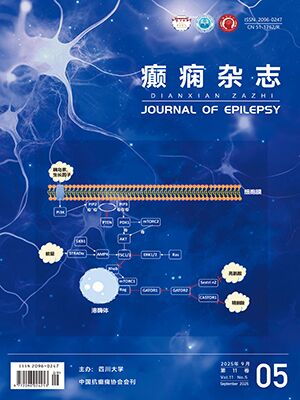| 1. |
Kawamura Y, Nakayama A, Kato T, et al. Pathogenic role of human herpesvirus 6B infection in mesial temporal lobe epilepsy. J Infect Dis, 2015, 212(7): 1014-1021.
|
| 2. |
Huang C, Yan B, Lei D, et al. Apolipoprotein 4 may increase viral load and seizure frequency in mesial temporal lobe epilepsy patients with positive human herpes virus 6B. Neurosci Lett, 2015, 593: 29-34.
|
| 3. |
Esposito L, Drexler JF, Braganza O, et al. Large-scale analysis of viral nucleic acid spectrum in temporal lobe epilepsy biopsies. Epilepsia, 2015, 56(2): 234-243.
|
| 4. |
Sellner J, Trinka E. Seizures and epilepsy in herpes simplex virus encephalitis: current concepts and future directions of pathogenesis and management. J Neurol, 2012, 259(10): 2019-2030.
|
| 5. |
Harberts E, Yao K, Wohler JE, et al. Human herpesvirus-6 entry into the central nervous system through the olfactory pathway. Proc Natl Acad Sci USA, 2011, 108(33): 13734-13739.
|
| 6. |
Li JM, Lei D, Peng F, et al. Detection of human herpes virus 6B in patients with mesial temporal lobe epilepsy in West China and the possible association with elevated NF-κB expression. Epilepsy Res, 2011, 94(1-2): 1-9.
|
| 7. |
Niehusmann P, Mittelstaedt T, Bien CG. Presence of human herpes virus 6 DNA exclusively in temporal lobe epilepsy brain tissue of patients with history of encephalitis. Epilepsia, 2010, 51(12): 2478-2483.
|
| 8. |
Theodore WH, Epstein L, Gaillard WD, et al. Human herpes virus 6B: a possible role in epilepsy? Epilepsia, 2008, 49(11): 1828-1837.
|
| 9. |
Karatas H, Gurer G, Pinar A, et al. Investigation of HSV-1, HSV-2, CMV, HHV-6 and HHV-8 DNA by real-time PCR in surgical resection materials of epilepsy patients with mesial temporal lobe sclerosis. J Neurol Sci, 2008, 264(1-2): 151-156.
|
| 10. |
Yao K, Crawford JR, Komaroff AL, et al. Review part 2: Human herpesvirus-6 in central nervous system diseases. J Med Virol, 2010, 82(10): 1669-1678.
|
| 11. |
Fotheringham J, Donati D, Akhyani N, et al. Association of human herpesvirus-6B with mesial temporal lobe epilepsy. PLoS Med, 2007, 4(5): e180.
|
| 12. |
Yamashita N, Morishima T. HHV-6 and seizures. Herpes, 2005, 12(2): 46-49.
|
| 13. |
Eeg-Olofsson O, Bergström T, Andermann F, et al. Herpesviral DNA in brain tissue from patients with temporal lobe epilepsy. Acta Neurol Scand, 2004, 109(3): 169-174.
|
| 14. |
Millichap JJ, Millichap JG. Role of HHV-6B infection in mesial temporal lobe epilepsy. Pediatr Neurol Briefs, 2015, 29(5): 40.
|
| 15. |
Donati D, Akhyani N, Fogdell-Hahn A, et al. Detection of human herpesvirus-6 in mesial temporal lobe epilepsy surgical brain resections. Neurology, 2003, 61(10): 1405-1411.
|
| 16. |
Uesugi H, Shimizu H, Maehara T, et al. Presence of human herpesvirus 6 and herpes simplex virus detected by polymerase chain reaction in surgical tissue from temporal lobe epileptic patients. Psychiatry Clin Neurosci, 2000, 54(5): 589-593.
|
| 17. |
Epstein LG, Shinnar S, Hesdorffer DC, et al. Human herpesvirus 6 and 7 in febrile status epilepticus: the FEBSTAT study. Epilepsia, 2012, 53(9): 1481148-8.
|
| 18. |
Seeley WW, Marty FM, Holmes TM, et al. Post-transplant acute limbic encephalitis: clinical features and relationship to HHV6. Neurology, 2007, 69(2): 156-165.
|
| 19. |
Howell KB, Tiedemann K, Haeusler G, et al. Symptomatic generalized epilepsy after HHV6 posttransplant acute limbic encephalitis in children. Epilepsia, 2012, 53(7): e122-e126.
|




